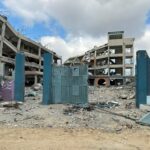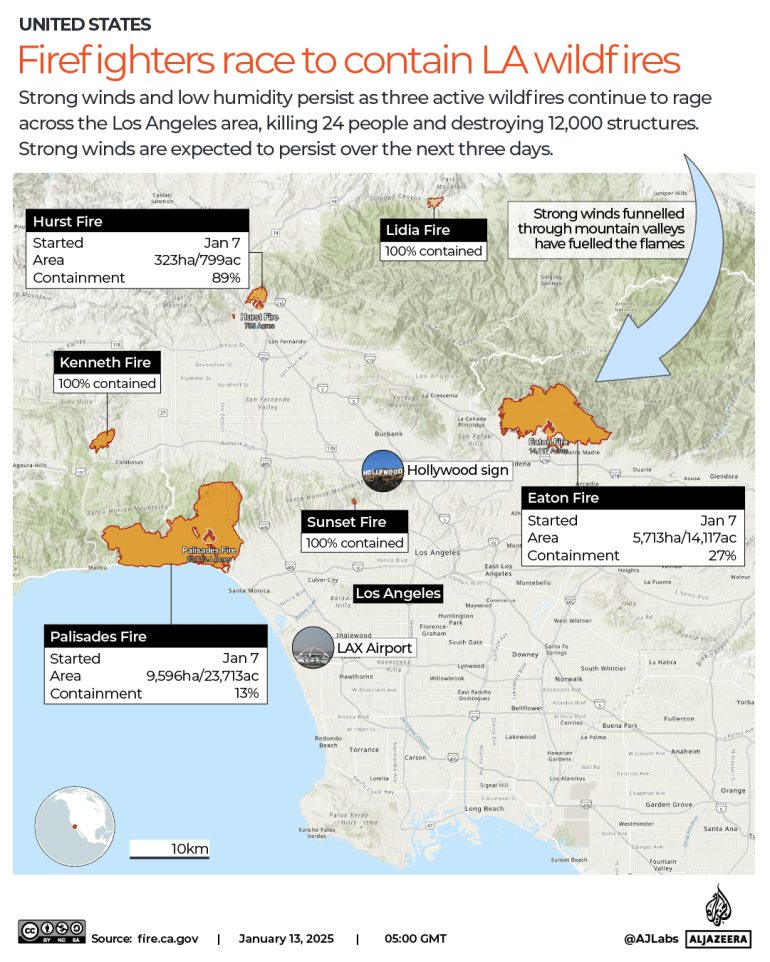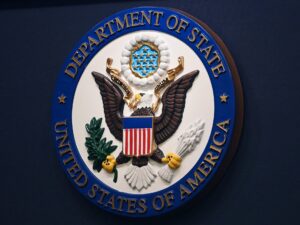California’s Los Angeles continues to grapple with the wildfires that broke out on January 7. The wildfires, which have killed 24 people, are presenting a range of challenges for authorities and firefighters attempting to extinguish them.
Here is a look at the latest state of the fires, and what is hindering the efforts of firefighters.
What is the current status of the LA wildfires?
The fires have burned 16,300 hectares (40,300 acres) and destroyed more than 12,300 structures, according to the California Department of Forestry and Fire Protection (Cal Fire).
Three fires are still actively burning, according to Cal Fire. The first and largest fire, which is burning in the Pacific Palisades, is at 13 percent containment, Cal Fire says. The Eaton fire, which is affecting Altadena, is 27 percent contained. The Hurst fire is 89 percent contained.
Containment is a term firefighters use to represent how much of a control line has been placed around a fire, which could then allow firefighters – at least in theory – to contain its spread. Containment does not equal safety.
Advertisement
What are the main challenges surrounding the wildfires?
Santa Ana winds and dry conditions have made it difficult for firefighters to extinguish the blaze. Under extreme wind conditions, it is unsafe for helicopters to fly too close to the ground, Joe Ten Eyck, wildfire/urban-interface fire programmes coordinator for the International Association of Fire Fighters, told The Washington Post. Last week, firefighting helicopters had to be temporarily grounded on Tuesday when the winds were particularly strong.
The wildfires have also stoked anxiety about insurance among those California homeowners who have lost their property. A week into the fires, California Insurance Commissioner Ricardo Lara invoked moratorium powers, suspending all policy cancellations and refusals for renewal for one year.
Issues with a low water supply have also proven to be a hindrance in firefighting efforts.
Why did the fire hydrants run dry?
The rescue efforts in Palisades were hindered by low pressure in the water supply at elevated areas.
Los Angeles receives its water supply from 114 tanks in total, all of which were fully filled before the fires. However, the three water tanks in the elevated Palisades were unable to be refilled due to high demand.
On the morning of January 8, Janisse Quinones, the chief executive of the Los Angeles Department of Water and Power, told reporters that water tanks in Palisades had been depleted.
“We pushed the system to the extreme,” she said, adding that “four times the normal demand was seen for 15 hours straight, which lowered our water pressure.”
Advertisement
The fire started in the Pacific Palisades neighbourhood at 10:30am (18:30 GMT) on Tuesday, according to Cal Fire. Two of the one million-gallon tanks, located at an elevation in the Palisades, ran out late on Tuesday.
By 3am (11:00 GMT) on Wednesday, the third tank had also run out, Quinones said. Water reserves were located at a lower elevation, which made it difficult to refill the high-elevation tanks.
Quinones said fire hydrants are built to extinguish fires from one or two houses at once, not hundreds of them.
On the night of January 9, firefighters stopped tapping into fire hydrants at all. On January 10, Democrat California Governor Gavin Newsom called for an independent investigation into the water shortages during the wildfires.
What really happened to the water supply?
Republican President-elect Donald Trump has blamed Newsom for damage caused by the fires.
On January 8, he wrote on his Truth Social platform that Newsom “refused to sign the water restoration declaration put before him that would have allowed millions of gallons of water, from excess rain and snow melt from the North, to flow daily into many parts of California, including the areas that are currently burning in a virtually apocalyptic way”.
The lack of water has also been criticised by others. Los Angeles Fire chief Kristin Crowley said during a local news interview: “When firefighters arrive at a hydrant, they expect water to be available.”
However, others have dismissed Trump’s allegations that California’s water policy is to blame. Instead, the shortages happened because Los Angeles is simply not designed to bear a fire incident as large and intense as the one that is ongoing in Palisades and elsewhere, they said.
Advertisement
Southern California has ample water stored, said Mark Gold, the water scarcity solutions director at the Natural Resources Defense Council and a Southern California Metropolitan Water District board member.
“It doesn’t matter what’s going on at the Bay-Delta or the Colorado [River] or Eastern Sierra right now,” Gold said. “We have all this water in storage right now. The problem is, when you look at something like firefighting, it’s a more localised issue on where your water is. Do you have adequate local storage?”
Large urban fires can cause damage to water pipes, causing them to leak great amounts of water, Andrew Whelton, an engineering professor at Purdue University told The Associated Press news agency.
When are the Santa Ana winds going to stop?
These hot, dry gusts blow from the interior of the region towards the coast and offshore. They dry out vegetation, making it very flammable.
On the night of January 7, gusts up to 100mph (160km/h) were recorded at higher elevations, according to AccuWeather meteorologist Danielle Ehresman.
While the winds slowed down by January 9, they are expected to intensify again until Wednesday evening, with officials warning that the strongest gusts are expected on Tuesday.
A red flag warning is in place until 6pm local time (02:00 GMT) on Wednesday.
Mountainous areas with elevation are expected to experience gusts between 25mph (40km/h) and 40mph (95km/h) in the coming days, and speeds could reach up to 70mph (112km/h).
Several measures are being taken at the federal and local levels to address the crisis. Private companies are also chiming in with solutions.
Advertisement
The Federal Emergency Management Agency (FEMA) authorised the use of federal funds to address the emergency on January 7.
Local hotels are offering discounts to those evacuating due to the wildfires. Ride-hailing applications, LA Metro and telecommunications providers are also offering limited free services to those affected by the fires in the area.
How many firefighters are in LA?
There are about 14,000 firefighters from California and eight other states, alongside Canada and Mexico, on the ground. Additionally, 1,400 fire engines and 84 aircraft have been deployed as part of the wildfire response.

What challenges will Los Angeles face from the wildfires?
Stephen Pyne, emeritus professor at Arizona State University’s School of Life Sciences, said wind is the first challenge to overcome.
“The fires are not over, and they won’t end until the winds die down – not just the Santa Ana winds over and down the mountains, but the local winds that will move in as the Santa Anas retreat,” he told Al Jazeera.
“The knock-on effects will last for years,” Pyne added.
Cleanup after the fire, he said, will be a long and expensive process. He noted that modern houses are filled with toxic plastic and electronics.
What is even more alarming is that California has become more susceptible to fires, and fire season has stretched longer. Newsom said in a video he posted on X on January 8 that there is no longer a fire “season” in California. “It’s year-round in the state of California.”
All hands are on deck to fight the #PalisadesFire in Southern California. California is deeply grateful for the brave firefighters & first responders battling the blaze.
We will continue to mobilize resources and support local communities as they respond to this severe weather. pic.twitter.com/JZrYy85e4z
— Governor Newsom (@CAgovernor) January 8, 2025
Advertisement











More Stories
US lists white supremacist Terrorgram network as ‘terrorist group’
Will the West move fast enough to lift al-Assad-era sanctions on Syria?
Biden administration proposes new rules to tighten grip on AI chip flows